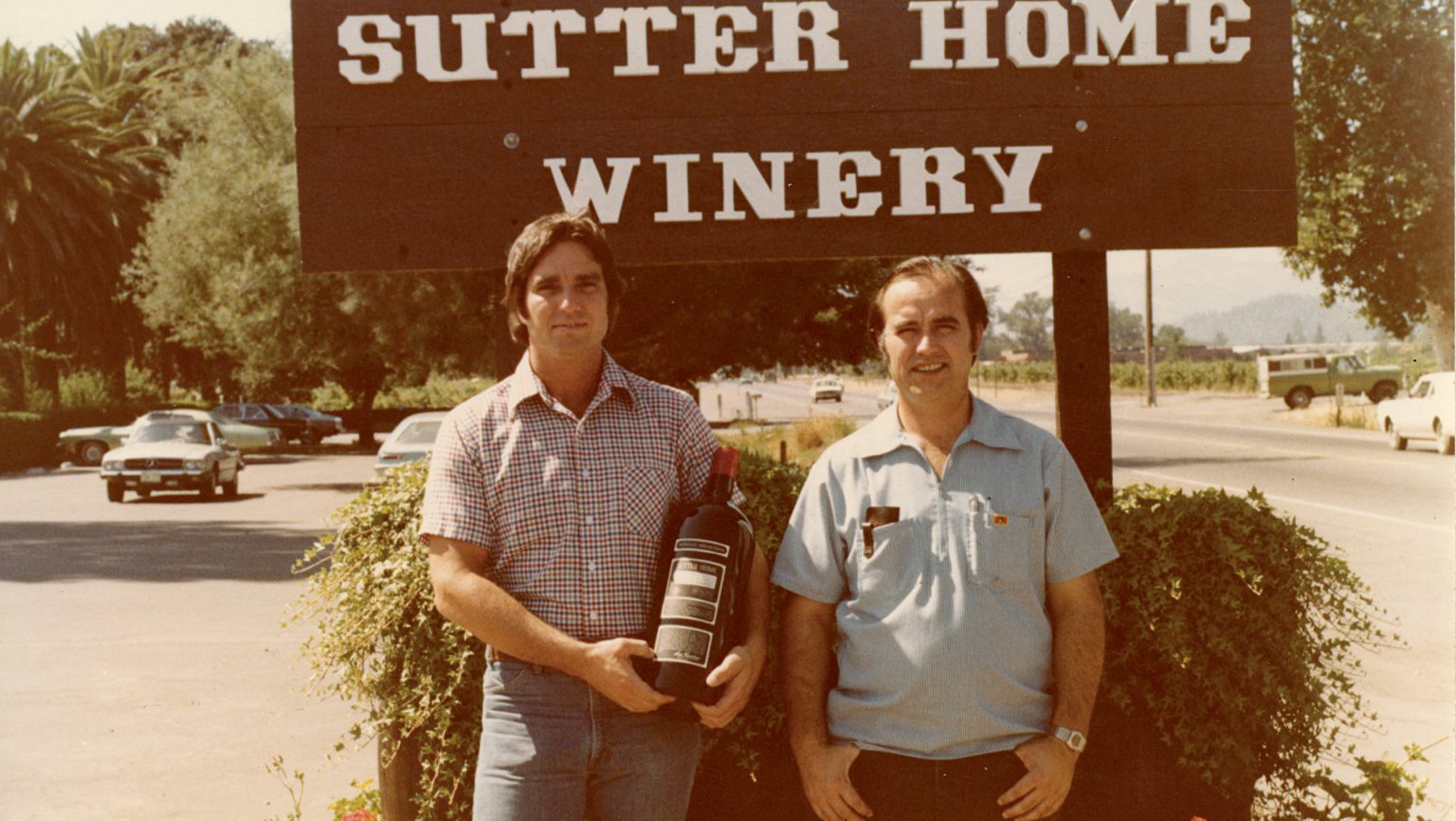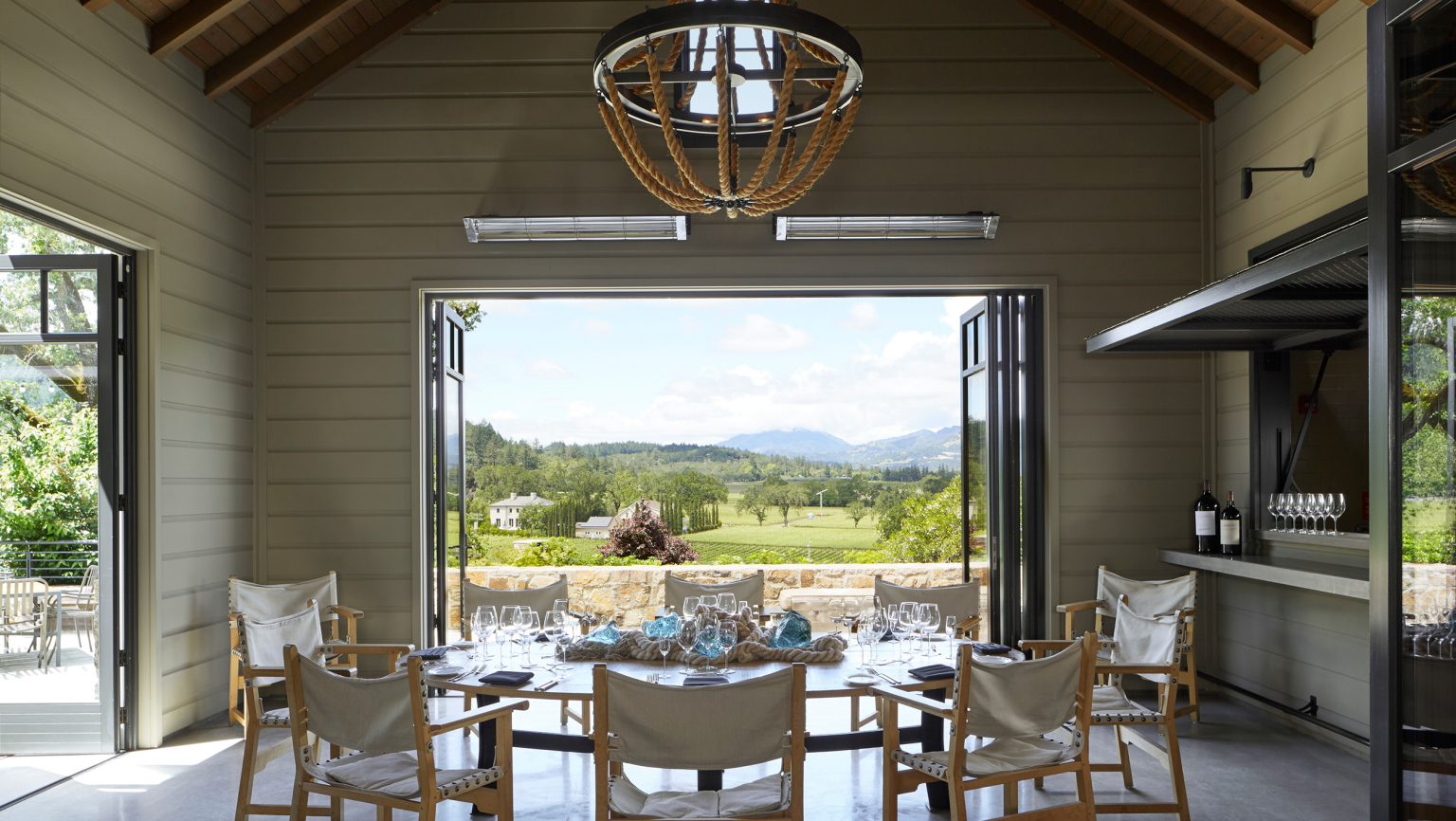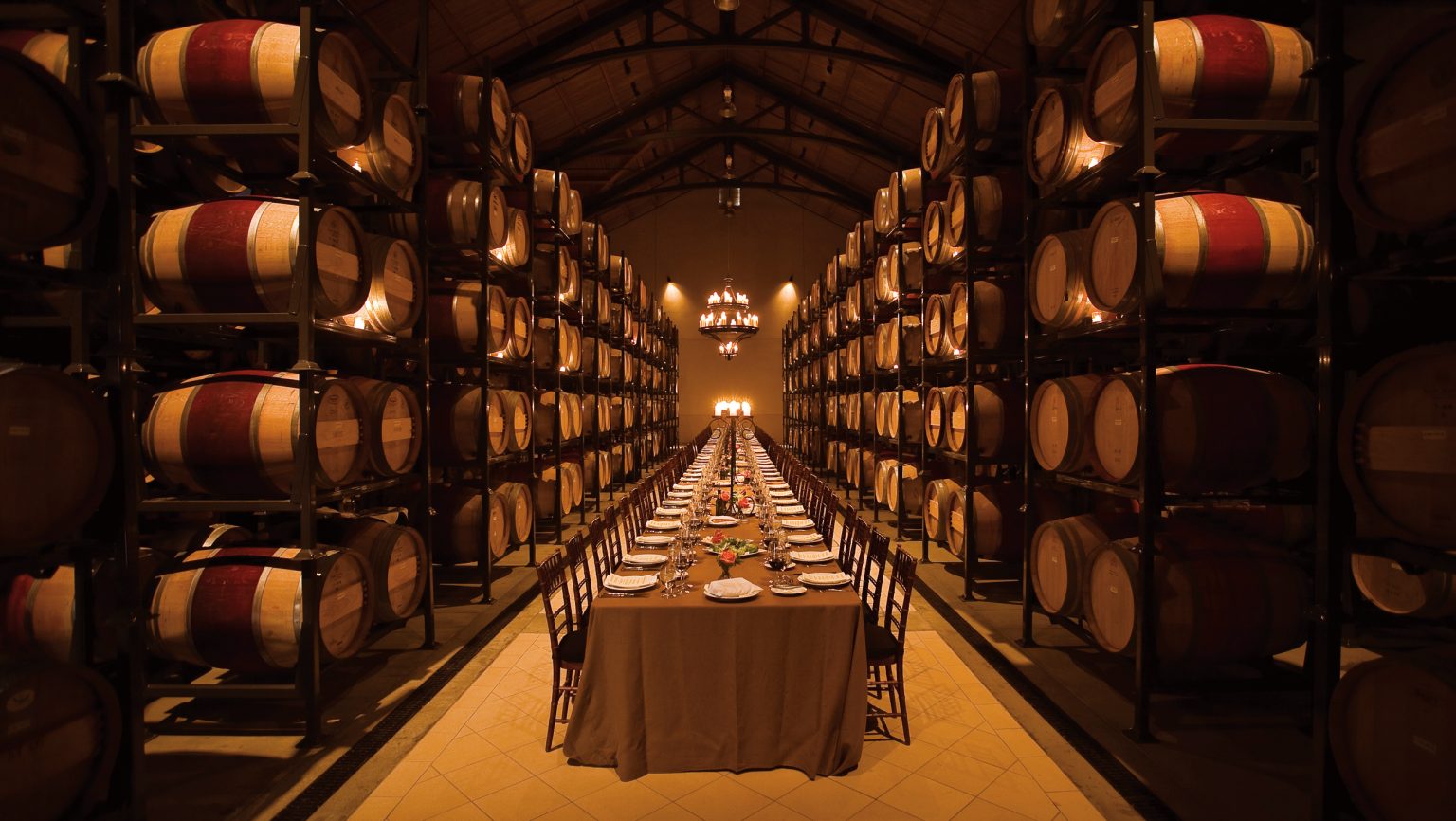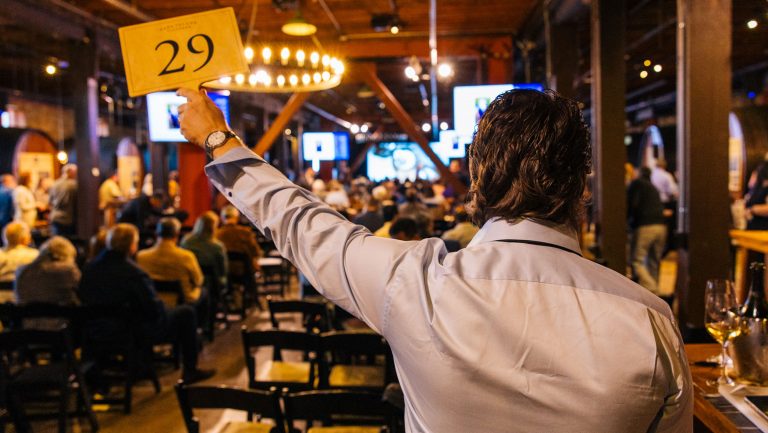Every four to six months, a group of the most venerated residents of Napa Valley gathers for lunch. Joseph Gallo, Mike Martini, Don Sebastiani Sr., and Fred Franzia are typically there, as are the benevolent ghosts of long-lived former members, like Frank Indelicato, John Parducci, Lou Foppiano, and Bob and Peter Mondavi. For two decades, these gentlemen, as well as a few ladies, have been calling themselves the Old Timers’ Club.
“We just get together and tell war stories,” says Marc Mondavi, the coproprietor of C. Mondavi & Family. “We damn near all have done business together in one way, shape, or form. Whether it’s grapes, bulk wine, or what have you.”
Any American consumer would recognize most of the surnames in the room. They’re mostly Italian, and they mostly come with superlatives attached: Gallo is the biggest, Franzia the most cutthroat, Mondavi the one with international cachet, and so on.

Don’t miss the latest drinks industry news and insights. Sign up for our award-winning newsletters and get insider intel, resources, and trends delivered to your inbox every week.
But what about those other two gentlemen of Italian descent? The Trinchero brothers, Bob and Roger, are 81 and 71 years old, respectively. And they have plenty of superlatives going for them. Trinchero Family Estates (TFE) is the second largest family-owned winery in the world. It also happens to be the fourth largest winery in the United States. Scions of one of the nation’s most important Italian families, wielding untold power and wealth within the wine industry, the Trincheros have made an indelible mark on the American trade.
But who are they, again?
“What can I say?” says Marc Mondavi when I ask him why most Americans don’t know the Trinchero name. “My uncle [Robert Mondavi] was an incredible promoter and got our name out there. The Trinchero family was hardworking and honest. They weren’t out there promoting their names and themselves. They are incredibly successful … So who’s got the perfect formula for success?”
Success came to the Trincheros in the same way it came to so many of the Old Timers’ Club members: on discount-supermarket shelves. Fred Franzia got his start with the Franzia boxed-wine business. The Indelicatos made their name with Delicato Shiraz. Gallo Family Vineyards is a mainstay at Walmart. And so on.
For the Trincheros, the supermarket was also the conduit, but the breakthrough wasn’t a brand. Rather, it was a specific style of wine, one that had never before been produced.
Beginning in 1972, Bob Trinchero used the saignée technique to intensify his red Amador County Zinfandel at his Sutter Home winery in St. Helena, California. On the suggestion of the renowned food importer and retailer Darrell Corti, Trinchero fermented the bled-off pink juice to dryness and bottled it. He named the pale dry wine after Switzerland’s ultra-pale oeil de perdrix rosé: Oeil de Perdrix—White Zinfandel Wine.”
Then, in 1975, an accident happened. The fermentation of Trinchero’s saignée-method rosé got stuck, rendering a semisweet (not dry) pink wine. He bottled it anyway. White Zin as we know it was born. And it was a hit.
“It was like having the reins of a runaway horse,” Roger Trinchero recalls. “Our biggest challenge in those years was making enough wine to satisfy the market while staying within our financial means. Both Bob and I worked 12-hour days, seven days a week, loading cases of White Zinfandel onto trucks that had queued up on Highway 29 waiting to pull into the winery.”
The early success of Sutter Home White Zinfandel was largely fueled by word-of-mouth recommendations. It was not until 1987 that the Trincheros held their first official sales meeting, which, fittingly, took place in Bob Trinchero’s backyard. By that point, Sutter Home White Zinfandel was America’s best-selling wine, with annual production at 2 million cases.
“People kept coming back, saying, ‘You’ve got to make more of that,’” says Roger. “We sat around, sort of scratching our heads, wondering what was going on. But we listened to our customers, and we respected what they liked, and it was evident [that] we should make more White Zinfandel. If we had listened to our critics, we would never have made White Zinfandel. They told us we were bastardizing the grape. We said, ‘Wait a minute. This is our business. And the customers, the people with the money, are saying this is what they want. We’re going to make it for them—we don’t care what you say.’”
Surprisingly, even though White Zin has fallen out of fashion today, sales haven’t dipped since the late ’80s. Enough of us, apparently, have grandmothers and aunts out there (here’s looking at you, Aunt Barb!) to have kept Sutter Home White Zin clipping along at those millions of cases annually. Even in 2017, the year of dry rosé mania, Sutter Home White Zin was the best-selling pink wine in the U.S. in the $10-and-under range.
The winery, which now sells 10 million cases of pink, white, and red wine annually, was originally founded in 1874 by a Swiss-German immigrant, then shut down during Prohibition. In 1948, John and Mario Trinchero, brothers from Italy who’d arrived in New York City, purchased the winery—name and all—just across the road from the Louis M. Martini winery in St. Helena. They made simple bulk wines and sold them to Napa Valley locals. When John Trinchero retired, in 1960, he turned the winery over to his brother.
That same year, Mario’s son Louis “Bob” Trinchero (his mother, Mary, who never liked the name Louis, called her son Bobby, and it stuck) took over as winemaker. Roger, the first Trinchero to attend college, returned from military service in Vietnam in 1972 to lead sales and distribution and help Bob with marketing and production.
If Bob struck gold with that stuck fermentation—and the idea to name his wine White Zinfandel—Roger struck gold with his keen sense of how to sell everything Bob vinified. “Roger Trinchero, in the 1980s, was a one-man sales and marketing guy,” recalls Tim McDonald, a Napa-based wine marketing consultant. “He built his brands at the retail level.”
Cultivating a Customer-Centric Strategy
Despite the wealth and power they now wield in the California wine business, Bob and Roger still feel more comfortable in the bottling line than the boardroom, and this groundedness is what has fueled the success of Trinchero Family Estates. A strong gut feeling for what appeals to the average consumer is a rare trait for those occupying the top tier of the wine business. Says Roger, “It’s a matter of listening to the consumer and trusting our instincts.”
In 1985, while a generation of culture snobs, fueled by Julia Child, among others, were mainlining pâte and Sauternes, the Trincheros began publishing a newsletter aimed at the 99 percent. The newsletter offered various information, including help with wine pairings: Which Sutter Home varietal tasted best with peanut butter? White Zinfandel. Which with popcorn? Chardonnay. Where can one buy peanut butter and popcorn? The supermarket. Where Sutter Home is sold.
In 1990 the Trinchero sales and marketing team, led at the time by Jim Miller and Alex Morgan, dreamed up an annual recipe contest. The Build a Better Burger contest continues to be a resounding success today, 28 years later. McDonald describes Build a Better Burger as “the sweetest promotion ever.”
“It gave retailers an excuse to cross-merchandise, put in floor displays,” says McDonald. “In the grocery space, it allowed them to sell more fresh-ground beef, buns, and ingredients. It also created consumer engagement with recipes and the chance to get noticed. And it sells an awful lot of Sutter Home.”
A similarly savvy move was the Trincheros’ prescient early investment in what has become a common sight these days—the single-serving bottle, or “split.” The Trincheros commissioned research in the 1980s that determined that the increasing number of American adults living alone were hesitant to purchase full-sized bottles of wine for themselves. The only single-serving sizes available at that time were the plastic 187 ml bottles used by airlines, so Roger Trinchero custom-ordered a small glass bottle mold for Sutter Home. Today, Sutter Home sells more than half of all 187 ml–sized wines in the United States.
While the brothers’ common touch bankrolled the business, they pivoted in the new millennium. Noting an increasing interest among consumers in higher-end wines, they struck partnership deals with respected Napa Valley names like Neyers Vineyards, Ziata, and Joel Gott. In a brilliant move, however, they secured the middle ground between bargain bottle and luxury label: In 2004, they purchased a well-situated Sonoma winery, Folie à Deux, for $16 million. The price looked high for an operation with a total annual production of about 30,000 cases.
But the Trincheros saw something else. In 2000, David Phinney, founder of the cultish brand Orin Swift, had begun producing The Prisoner. It was mysteriously packaged, with a label featuring an ominous etching by the Spanish artist Francisco de Goya. Inky-black in color and chocolatey on the palate, the wine was an unlikely Napa Valley cuvée of Cabernet Sauvignon, Syrah, Charbono, and Petite Sirah, plumped up by plenty of luscious Zinfandel. The Prisoner started appearing on best-of-the-year wine lists; it turned drinkers on to red blends. And its irresistible name—unusual for the time—was on everyone’s lips: “Have you tasted The Prisoner yet?”
Folie à Deux came with a second label, called Ménage à Trois—a name that sounds silly now but was shockingly irreverent at the time. “Ménage à Trois was clever when it was invented in 1996. The public might not have been ready for a wink and a nod any earlier,” observes Tim McDonald. The Trincheros saw the value of that wink and knew, given the success of The Prisoner, they could turn Ménage à Trois into a hit.
As with The Prisoner, the wine’s name stopped shoppers in their tracks. And as with The Prisoner, it was a plush red blend. But unlike The Prisoner, it was priced for the wine-curious shopper ready to trade up from the jugs on the bottom shelf at the grocery store. Today, the red blend is the third-largest wine category in the U.S., and within it, Ménage à Trois Red is the top seller, at more than 1.5 million cases annually. Ménage à Trois is TFE’s second-largest brand after Sutter Home, accounting for a total of 3 million cases in annual sales, with bottles priced at $10 to $15 retail.
The icing on the cake was the early adoption by TFE of quirky, youthful lines, like Bandit, that captured the millennial vibe while staying in the supermarket price point. A partnership with Charles & Charles was a coup; the brand, helmed by two irreverent industry icons who exemplify the new face of wine, just happens to produce one of the best-selling rosés in the $10–$13 price range. The Trincheros have cornered the market on pink.
Leveraging the Family Brand
A decade ago, TFE debuted a new winery in St. Helena at the address of the former Folie à Deux winery. Winemaker Mario Monticelli, who earned his chops at the neighboring Melka Estates and Antinori in Chianti, Italy, makes plush, powerful Bordeaux-style reds there that range in price from $50 to $200 and have received critical scores in the ‘90s. The winery’s name? Trinchero Napa Valley.
During all those years, the Trincheros never printed their own name on their labels. “It’s very smart to not have your name on the everyday stuff,” observes Don Sebastiani Sr., head of the Sebastiani winemaking clan. “We had our family name all over our everyday wines. It made our name better known, but it also lowers your image because everyone associates you with a $3–$5 wine. I took our name off the jug wines and put it on our premium wines, but it’s hard to trade up.”
Trinchero Napa Valley is a departure for a company that made millions matching wine with burgers and popcorn. The winery’s new hospitality center, which debuted in June 2016, is sumptuous—outfitted like a contemporary hunting lodge, with private dining spaces, a members’ lounge, a secluded bocce court, and an air of sophisticated mystery.
In an arresting corner of the grand tasting room, two steampunkish rolling carts stand in front of a parchment-colored wall. Each cart is a tasting station, supporting a clear glass tube of soil, a horn chalice, and an egg-shaped concrete vessel stamped with the letters TNV and filled with wine. Behind the carts are charcoal sketches by decorative painter Michael J. Duté that depict the zodiac symbols of the Trinchero family, along with winemaking diagrams. White Zin and peanut butter have no place here.
Could the arrival of Trinchero Napa Valley mark a new, vainglorious era for TFE? The transfer of power is never easy for a family business, and the past couple of years appear, at least from the outside, to have been somewhat rocky for the brothers. Nephew Bob Torres (his mother, Vera Trinchero Torres, died in 2014), who graduated from the University of California at Berkeley with a degree in architecture, was the visionary behind the TNV hospitality center. Just before the grand new tasting room opened, Roger Trinchero told the Napa Valley Register, laughing, “We told Bobby that he had an unlimited budget … And somehow, he managed to exceed it.”
Torres remains principal, vice chairman, and director of executive administration at Trinchero Family Estates, while his brother Tony plays a similar role with the business. In May 2017, Roger Trinchero announced the appointment of longtime Trinchero executive—and non–family member—Bob Torkelson to the position of president and CEO, with Roger retiring from that role but remaining as chairman of the board of directors.
Meanwhile, Roger’s son Carlo—whose star rose quickly when he launched the Taken brand in partnership with Josh Phelps, the son of the well-known and Bordeaux-trained Napa Valley winemaker Chris Phelps—made headlines when he was arrested in May 2016, and sentenced in February 2017, on domestic violence charges. A month after Carlo Trinchero’s sentencing, Phelps announced that he had sold his share of Taken to TFE.
Then in October, wildfires ravaged Napa Valley and Sonoma County, displacing many TFE employees. The Trinchero brothers showed their true colors. They donated $250,000 to the Napa Community Foundation to aid in fire relief and recovery efforts. Trinchero Family Estates fed and outfitted first responders with supplies, supported employees who had been left homeless, donated all proceeds from tasting fees at TFE wineries through November 30, and matched employee donations, 2 to 1, to the Trinchero Family Estates Family in Need Fund, which directly helped team members affected by the fires.
Bob and Roger Trinchero have long been acknowledged in the Napa Valley community as generous philanthropists and benevolent employers. When they received the Wine Enthusiast Wine Star Award for lifetime achievement in September 2017, their peers cheered them on. “They run a very good organization and they are very nice people. I think that they are truly the American success story,” says Eric Wente, an Old Timer and the fifth-generation proprietor of the country’s oldest continuously operated family-owned winery, Wente Vineyards.
Don Sebastiani Sr. is more direct: “I view the Trincheros with two emotions,” he says. “One is admiration. The other is jealousy. In my case, it’s mostly the latter.”

Dispatch
Sign up for our award-winning newsletter
Don’t miss the latest drinks industry news and insights—delivered to your inbox every week.
Katherine Cole is the author of four books on wine, including Rosé All Day. She is also the executive producer and host of The Four Top, a James Beard Award–winning food-and-beverage podcast on NPR One. She is currently working on a fifth book, Sparkling Wine Anytime (Abrams), to be published in Fall 2020.












